|
 |
|
 |
|
|
When Paul, a native
of Tarsus located in modern-day Turkey, approached
Caesarea, his eyes may have been momentarily dazzled
by the gleaming white marble temple supported by
rose granite columns. Some decades earlier,
Caesarea’s pagan temple had been erected on a huge
artificial platform by Herod the Great Builder.
But such magnificent works of art and symmetry did
not distract Paul in the least.
He was a man on a mission. With fire in his
belly. It was at Caesarea that Paul bonded
with the evangelist Philip whom he had once
persecuted and driven out of Jerusalem. Now
they were friends and fellow-believers. |
| |
|
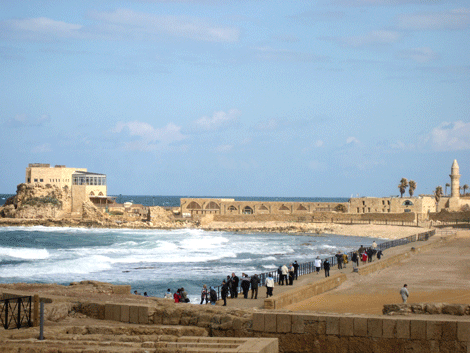 |
|
Photo: Gila
Yudkin |
|
View of Caesarea with the arena of
the hippodrome on the right |
|
|
| The day of Pentecost
was imminent and Paul departed for the Holy City of
Jerusalem. During a visit to the Temple, he
was attacked by an enraged mob and dragged out of
the sacred precinct. Paul was rescued by a
Roman officer and given permission to address the
rabble-rousers. Paul told them how he had once
been just as zealous as they were, until he was
blinded on the road to Damascus. (Acts 22) |
| |
|
 |
|
Courtesy of Wikipedia commons |
|
Paul blinded on the road to
Damascus by my favorite all-time painter Caravaggio |
| |
|
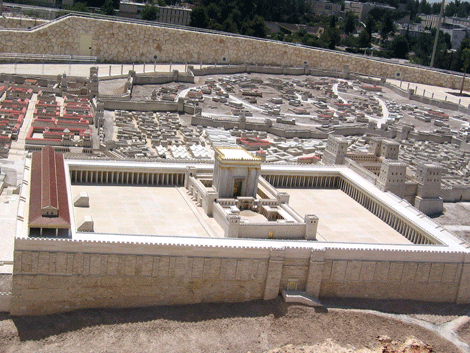 |
|
Photo: Gila
Yudkin |
|
Model of the Temple courtyard in
Jerusalem where Paul was arrested |
| |
| When the mob lunged
for Paul once again, the tribune ordered he be
arrested and brought into the barracks for flogging
and interrogation. Paul insisted upon his
right as a Roman citizen for a fair trial first,
before being bound. To insure Paul’s safety,
the Roman commander organized an armed guard of 200
soldiers, 70 cavalry and 200 spearmen to transport
Paul under cover of darkness to Caesarea to the
Roman governor, Felix. |
| |
|
Felix promised Paul a hearing and ordered that he be
kept under guard in Herod’s praetorium, probably in
the palace built on a promontory by the sea.
Imprisoned for two years, Paul was occasionally
called before Felix for further questioning.
It was obvious that Felix was waiting for his palms
to be greased. In today’s Middle East this
type of bribe is called baksheesh. (It’s a
handy term to know on a Holy Land pilgrimage!) |
|
|
|
Felix was eventually replaced by Festus who
consulted with King Agrippa and Bernice about
resolving Paul’s case. Agrippa decided he
would like to hear Paul himself. It was in the
audience hall in the palace, or perhaps in the
theater or hippodrome that Paul passionately
defended his beliefs. So moved was King
Agrippa, that he would have freed him on the spot
had Paul not appealed to Caesar for trial in Rome.
(Acts 26:32) |
| |
|
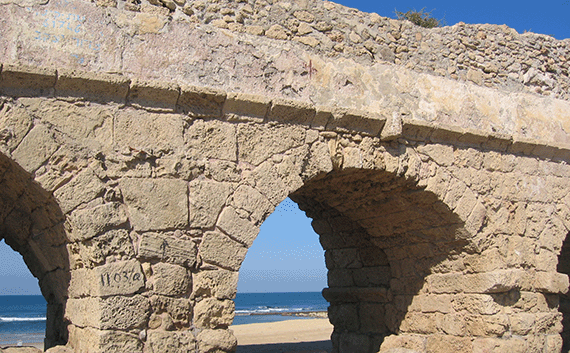 |
|
Photo: Gila
Yudkin |
|
Caesarea aqueduct from the time of
Paul |
|
|
|
A great place to retell Paul’s story and even recite
his passionate speech is in Caesarea’s
2,000-year-old hippodrome. The hippodrome was
a racetrack for horses and chariots built by Herod
the Great. (Hippo is Greek for horse and drome
is Greek for racetrack.) Although immediately
adjacent to Herod’s palace and next to the theater,
the hippodrome was only discovered in 1992! On
its eastern side all twelve original rows of seats
and aisles are still in place. |
|
|
|
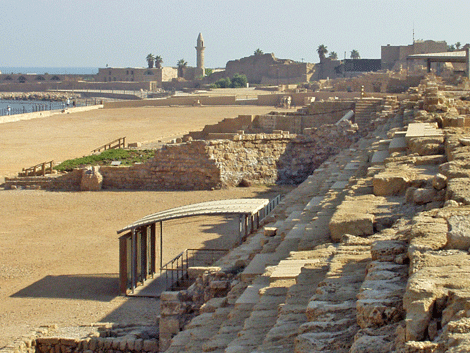 |
|
Photo: Gila
Yudkin |
|
Seats of the 2.000-year-old
hippodrome at Caesarea |
|
|
|
During the time of Paul, chariot-racing was the most
popular form of public entertainment in the Roman
Empire. Roman passions ran high when it came
to chariot-racing and frequently revolts broke out
in the hippodrome. The charioteer drove
standing upright in his chariot, wearing a light
helmet and a belted tunic in the color of his team
-- white, scarlet, sea blue or leek green.
Eventually these colors came to be identified with
political parties. |
|
|
|
The chariots were built as light as possible, purely
for speed and were drawn by two or four horses.
Sometimes even more. The larger the teams of
horses, the more expert the driver needed to be.
The public adored the top drivers -- they were
comparable to our modern day million-dollar
athletes. |
|
|
|
The VIP spectators sat where the arena sloped at an
angle where crashes were frequent and spectacular.
When we are on tour at Caesarea, we may even sit in
the VIP section. I’ll show you where the spina
was, the decorative wall in the middle of the arena
which had a device like an abacus to count the laps
and red cones to stimulate the horses. |
|
|
|
The race usually consisted of seven laps. The
first to complete all seven was declared the winner.
During the time Augustus ruled in Rome, there were
often as many as twelve races a day. During
the time of Paul, there could be as many as
twenty-four! |
|
|
|
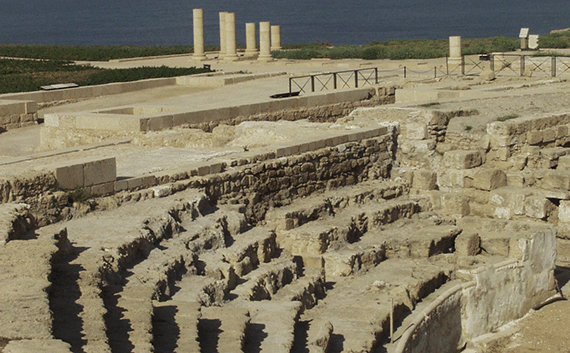 |
|
Photo: Gila
Yudkin |
|
SW corner of hippodrome with the
Roman governor's palace towards the sea |
|
|
|
I’ve found that especially in the winter months when
the more-crowded theater closes early, the
hippodrome with its spectacular view of the
Mediterranean Sea framed by the southern breakwater
of Herod’s port is an inspiring and relaxing venue
for the Paul story. Here our minds can wander
freely around the outsized personality of Paul. |
|
|
| We can be amazed at
his missionary zeal despite a multitude of earthly
challenges and a milieu of pagan temptations.
And he could have, with characteristic charisma and
confidence, appeared before Agrippa right where we
are sitting, before being sent off to Rome! |
|
|
Not only Paul, but Peter, Pilate, Philip and
Cornelius all spent time in Caesarea. You will
be blessed if you give Caesarea the time that it
deserves on your next pilgrimage.
|
|
Postscript January 2025: More on Chariot
Racing! |
| |
|
While touring the new National
Archeological Campus near the Israel Museum, I was
startled to see what is called the “blues
inscription” from Beth Shean, known as Scythopolis
in the Roman era. It was discovered in a
salvage dig after the turn of the millennium. |
|
|
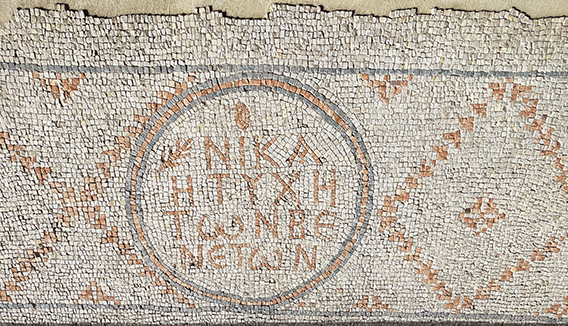 |
|
Photo: Gila Yudkin |
|
Victory to the Blues! found in
front of a shop in Beth Shean |
|
|
|
The inscription was found at the entrance to a shop
on the 5th century sidewalk. The mosaic states in
Greek “Victory (Nika) to the Blues (Veneti).”
Throughout the Roman and Byzantine empires there was
fierce (and often violent) rivalry between the
“greens” and the “blues” chariot teams and their
fans. In the eastern Mediterranean, the
“Blues” were more popular. Later, in 532 AD
there was even a week of rioting in Constantinople
(today’s Istanbul) when the Blues’ super patriotic
fans thought that the emperor Justinian had
discriminated against them. According to
contemporary accounts as many as 30,000 people were
killed in the chaos. |
|
|
|
The inscription mentions Tyche, the goddess of
fortune whom the shopkeeper hoped would bestow her
graces to lead his favorite team, the Blues to
victory. |
|
|
|
Copyright 2009, 2012, 2025 Gila Yudkin. Permission
needed for any reuse. |
|
|
|
Gila
Yudkin, who has been guiding for
four decades, witnessed the
excavation of Caesarea’s hippodrome, week by week.
She and her groups frequently interviewed the
immigrant diggers and she herself has gone on
numerous tours with the archeologists. She’d
be delighted to share her knowledge, passion for
archeology and sense of fun with you and your
friends during your next tour. |
|
|
|
When Mark Twain visited the Holy
Land in 1867, Caesarea was not on his itinerary, for
nothing had yet been unearthed. If you are a
Mark
Twain fan, you may enjoy his tips for
Holy Land pilgrims illustrated by modern day photos. |
| |

